Pancreatic Cancer: Symptoms, Causes, and Treatment
April 27, 2025

Pancreatic cancer occurs when tumors form in the pancreas, a critical organ located behind the stomach that plays a crucial role in digestion. The pancreas also produces two vital hormones: glucagon and insulin. These hormones are at the helm of controlling glucose (sugar) metabolism. Because of the location of the pancreas, pancreatic cancer may be difficult to detect and is often diagnosed in more advanced stages of the disease.
Types of Pancreatic Cancer
There are two main types of pancreatic cancer, based on the kind of cell they start in:
| S.No | Type Name | Definition |
| 1. | Pancreatic adenocarcinoma | The most typical type of pancreatic cancer. It starts in exocrine cells, which produce enzymes that aid digestion. |
| 2. | Pancreatic neuroendocrine tumours | Rarer type of pancreatic cancer in the endocrine cells. It releases hormones that affect everything from mood to metabolism. |
Causes of Pancreatic Cancer
The cause of pancreatic cancer is unclear. However, many risk factors for this illness are known, and some contribute to the development of malignant cells.
- Oncogenes are genes that aid cell growth, division, and survival.
- Tumor suppressor genes help regulate cell division or prompt cells to die at the appropriate moment.
- DNA changes that activate oncogenes or silence tumour suppressor genes can result in cancer.
Inherited Gene Mutations
Your parents can pass along mutations that make you more likely to get pancreatic cancer. Doctors have linked the condition to the BRCA1 and BRCA2 genes, which produce proteins that help repair damaged DNA, as well as genes that cause colorectal cancer and other health issues. These mutations cause up to 10% of pancreatic cancer cases.
Acquired Gene Mutations
Many gene changes happen after you’re born. Sometimes, they change because you come into contact with chemicals like those in tobacco or smoke. Other mutations occur at random as your cells copy your DNA and divide.
Risk Factors of Pancreatic Cancer
While the underlying cause of pancreatic cancer is unknown, certain factors may increase your risk of developing it. These include,
- Sex: Men are slightly more likely to develop pancreatic cancer than women.
- Age: People between 65 and 74 are more likely to be diagnosed with pancreatic cancer.
- Family history: The chance of developing other cancers may be increased by a family history of the disease or by genetic abnormalities associated with pancreatic cancer. It’s advised to note your family’s history of medical issues.
- Tobacco use: Smoking cigarettes may account for 20 to 35 per cent of pancreatic cancer cases.
- Heavy alcohol consumption: Having three or more alcoholic drinks a day may increase the risk. Drinking alcohol can also contribute to pancreatitis, another risk factor.
- Chronic and hereditary pancreatitis : This refers to inflammation of the pancreas. Chronic pancreatitis often results from heavy drinking over a long period. Pancreatitis can also be hereditary.
- Weight: Being overweight or obese, particularly in early adulthood.
- Diet: Eating a diet high in red and processed meats, fried foods, sugar, or cholesterol may increase your risk, but experts are still deciphering the exact link between dietary factors and pancreatic cancer risk.
- Workplace exposure :
- Working with certain chemicals, particularly those used in metalworking and pesticides, may be a factor in up to 12 per cent of pancreatic cancer cases.
- Diabetes: People have a higher risk of developing pancreatic cancer if they have type 1 or type 2 diabetes.
- Infections: A history of H. Pylori infection in the digestive tract may increase the risk, though the exact link to pancreatic cancer isn’t clear. Having hepatitis B may also increase your risk by up to 24 per cent.
Symptoms of Pancreatic Cancer
Most people don’t experience early signs of pancreatic cancer. However, as the disease progresses, people may notice
- Upper abdominal pain that may spread to the back
- Depression
- Unintentional weight loss
- Jaundice
- Tiredness
- Loss of appetite
- Light-coloured poop
- Dark-coloured urine
- Weight loss
- Blood clots in the body
- Itchy skin
- New or worsening diabetes
- Nausea and vomiting
Pancreatic Cancer Stages
When pancreatic cancer is discovered, doctors will likely perform tests to determine whether the cancer has spread. These might include imaging tests, such as a PET scan or blood tests. They will use the results of these tests to determine the stage of the cancer. Staging helps determine the extent of the tumor, which in turn helps identify the best treatment option.
The stages of pancreatic cancer are
| Stages | Definition |
| Stage 0 | A precancerous stage. Abnormal cells in the pancreas become cancerous. |
| Stage 1 | The tumour is only in the pancreas |
| Stage 2 | The tumour has spread to nearby abdominal tissues or lymph nodes |
| Stage 3 | The tumour has spread to major blood vessels and lymph nodes |
| Stage 4 | The tumour has spread to other organs like the liver. This is also called metastatic cancer. |
Symptoms of Pancreatic Cancer Stages
Stage 0
This is the earliest stage of pancreatic cancer, though it may not necessarily involve cancer. It means that abnormal cells have been detected and could potentially become cancerous. This stage doesn’t include any symptoms.
Stage 1
Pancreatic cancer of stage 1 consists of a tumour only in the pancreas. This stage is divided into two subcategories depending on the size of the tumour.
- Stage 1A: The tumour measures 2 cm or less.
- Stage 1B: The tumour measures more than 2 cm but less than 4 cm.
Stage 1 of pancreatic cancer typically doesn’t cause noticeable symptoms. Pancreatic cancer may be curable with surgery if detected at this stage.
Stage 2
Stage 2 pancreatic cancer is cancer that remains in the pancreas but may have spread to a few nearby lymph nodes or blood vessels.
This stage is divided into two subcategories, depending on where the cancer is and the size of the tumour:
- Stage 2A: The tumour is more significant than 4 centimetres but hasn’t spread to lymph nodes or nearby tissue.
- Stage 2B: The tumour has spread to nearby lymph nodes but not to more than three.
Symptoms of stage 2 pancreatic cancer tend to be very subtle and may include:
- Jaundice
- Changes in urine colour
- Pain or tenderness in the upper abdomen
- Weight loss
- Loss of appetite
- Fatigue
Treatments may include:
- Surgery
- Radiation
- Chemotherapy
- Targeted drug therapies
Stage 3 & Stage 4
Stage 3 pancreatic cancer is a tumour in the pancreas and possibly nearby sites, such as lymph nodes or blood vessels.
Symptoms of stage 3 pancreatic cancer may include:
- Pain in the back
- Pain or tenderness in the upper abdomen
- A loss of appetite
- Weight loss
- Fatigue
- Depression
Pancreatic Cancer Treatment
Pancreatic cancer treatment is to kill cancerous cells and prevent cancer from spreading. The most appropriate treatment option will depend on the stage of the tumor. The main treatment options include,
- Surgery: Surgical treatment of pancreatic cancer involves removing portions of the pancreas. While this can eliminate the original tumour, it won’t remove cancer that has spread to other areas. As a result, surgery usually isn’t recommended for advanced-stage pancreatic cancer.
- Radiation therapy: X-rays and other high-energy beams are used to kill cancer cells.
- Chemotherapy: Anticancer drugs kill cancer cells and help prevent their future growth.
- Targeted therapy: Medications and antibodies are used to individually target cancer cells without harming surrounding healthy cells, which can occur with chemotherapy and radiation therapy.
- Immunotherapy: Various methods trigger your immune system to target and attack cancer cells.
Frequently Asked Questions
1. Who is most likely to get pancreatic cancer?
The risk of developing pancreatic cancer goes up as people age. Almost all patients are older than 45. About two-thirds are at least 65 years old. The average age at the time of diagnosis is 70.
2. What are the early warning signs of pancreatic cancer?
Early warning signs of pancreatic cancer can include dark-coloured urine, itchy skin, and digestive problems such as abnormal stools, nausea, or vomiting. Pain in the upper abdomen, which may also radiate to the back, is another common symptom. Many individuals may experience a loss of appetite, a swollen gallbladder, or the sudden onset of diabetes as early indicators of the disease.







